Matte Black, Brushed Bronze, and Satin Brass: How Metal and Glass Work Together on Glass Showers
23rd Nov 2022

Minimal metal is a hallmark of frameless glass shower design, but Matte Black, Brushed Bronze, and Satin Brass metal accents are are very much in vogue today. In fact metal shower door components are indispensable and impact an enclosure’s overall style. A customer can choose metal that is more low profile or more prominent, depending on the desired effect, but the hardware always makes a difference. Let’s examine how the right choices of glass and hardware come together to create a dream shower.
1. What kind of glass is used to construct a shower enclosure?
2. How are different glass styles used?
3. What handle options are available for glass shower doors?
4. Can different types of hinges be used on glass doors?
5. What about hardware for frameless rolling doors?
6. Is U-channel ever needed on a glass shower enclosure?
7. Are other components needed besides glass and metal?
8. What are the best options for minimizing metal?
9. What about ornamental hardware that dresses up the enclosure?
10. How can I get the shower hardware needed by my business or for my DIY project?
.
.
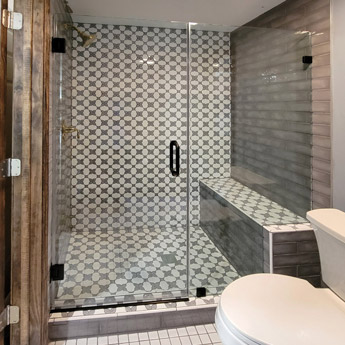 1. What kind of glass is used to construct a shower enclosure?
1. What kind of glass is used to construct a shower enclosure?
Before we consider specific pairings of glass and Matte Black, Brushed Bronze, or Satin Brass hardware, let’s cover some shower door basics. Glass showers of old were made from annealed glass, what you might think of as “regular” glass. There was no problem with this in terms of appearance, but annealed glass is very dangerous when broken, and it breaks all too easily. Thankfully, a stronger and safer option became available with the development of tempered glass. Glass is tempered by heating it and then quickly cooling it down. This process quadruples its strength and changes how the glass behaves in the – now unlikely – event of breakage. If tempered glass gets shattered, it breaks apart into small chunks without the razor sharp edges and jagged shards that result from broken annealed glass.
Beginning in the 1960’s, shower doors and enclosures have been made from tempered glass, which makes a lot of sense. You will not find annealed glass shower doors being manufactured today. However, there can be instances in which an even safer option than tempered glass is called for. For example, a person with a higher risk of falling would want a glass door that would remain structurally intact if fractured. In cases like this, a shower door made of laminated glass or laminated tempered glass can be ordered. Laminated glass consists of two layers of glass attached to a transparent vinyl interlayer which holds everything together even if the glass gets broken. In summary:
- Annealed glass is no longer used for manufacturing shower doors or enclosures. Antique items may still be sold, but customers should be aware of the safety hazards associated with a door that can more easily break and that yields very sharp glass fragments.
- Tempered glass is used on most shower doors and enclosures. It is about 4 times more durable than annealed glass and less hazardous if compromised.
- Laminated glass or laminated tempered glass can be used on custom showers for enhanced safety.
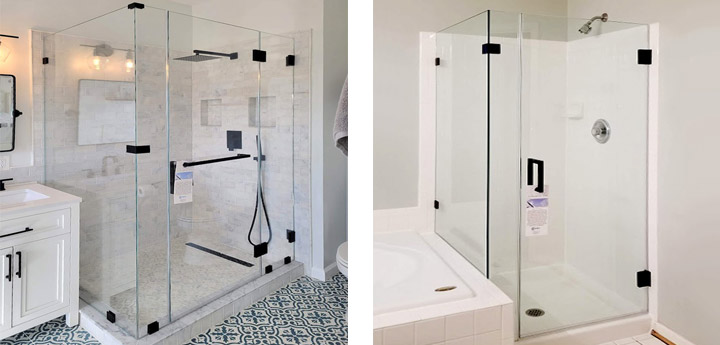
.
.
2. How are different glass styles used?
The impact of a metallic finish varies depending on the type of glass it is paired with. Tempered glass is typically available in the following styles:
- Standard clear
- Low-iron ultra clear
- Acid-etched (frosted)
- Patterned
- Tinted
- Cast
Metal hardware – especially bold choices like Satin Brass, Matte Black, and Brushed Bronze – will be more visible against clear, frosted, patterned, or cast glass, and slightly less vibrant against tinted glass. Let’s get answers to FAQs about when and why these different glass styles are chosen.
.
![]() Which style is most popular and why?
Which style is most popular and why?
![]() Clear shower glass is the most popular choice today and has been for quite some time. Standard clear glass is chosen by many homeowners, including those who are remodeling on a budget. Ultra-clear glass is selected by homeowners who want to minimize the greenish coloration that occurs around glass edges due to its iron content. Reasons for the popularity of transparent glass include:
Clear shower glass is the most popular choice today and has been for quite some time. Standard clear glass is chosen by many homeowners, including those who are remodeling on a budget. Ultra-clear glass is selected by homeowners who want to minimize the greenish coloration that occurs around glass edges due to its iron content. Reasons for the popularity of transparent glass include:
- Homeowners don’t want to hide their new tile and shower design behind obscure glass.
- Clear glass keeps the shower’s interior very bright and airy.
- By visually combining the shower with the rest of the room, clear glass makes a space seem larger.
- Clear glass has a sleek surface that is easier to keep clean than acid-etched, patterned, or cast glass.
- The appearance of transparent glass is simple and timeless, so it matches changing bathroom décor styles and color schemes.
.
![]() What glass styles are used for privacy?
What glass styles are used for privacy?
![]() Acid-etched and patterned glass are the most popular choices for shower stalls with more privacy. Sometimes only a portion of a glass panel is frosted, and sometimes both clear and obscure panels are used on one enclosure. Tinted glass offers a lesser degree of privacy, but its smooth surface makes cleaning easier. Cast glass also provides privacy but is less commonly used.
Acid-etched and patterned glass are the most popular choices for shower stalls with more privacy. Sometimes only a portion of a glass panel is frosted, and sometimes both clear and obscure panels are used on one enclosure. Tinted glass offers a lesser degree of privacy, but its smooth surface makes cleaning easier. Cast glass also provides privacy but is less commonly used.
.
![]() What is cast glass and why is it not used more often?
What is cast glass and why is it not used more often?
![]() A panel of cast glass is formed in a mold and has dramatic texturing. The look is striking without a doubt, so it’s a fashionable way to make a shower stall more secluded. However, the deep ridges and grooves that give the glass character also make it significantly harder to clean.
A panel of cast glass is formed in a mold and has dramatic texturing. The look is striking without a doubt, so it’s a fashionable way to make a shower stall more secluded. However, the deep ridges and grooves that give the glass character also make it significantly harder to clean.
.
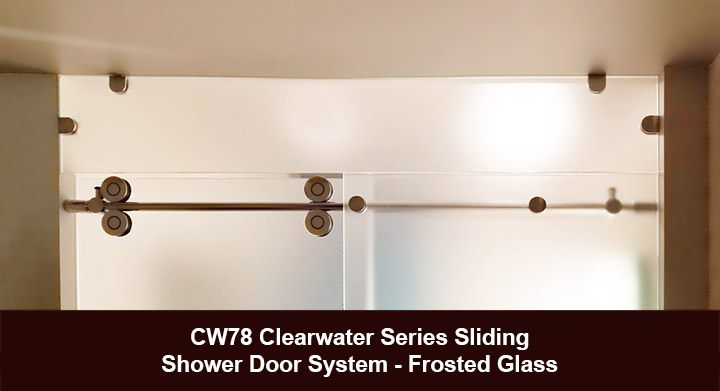
.

.

.
.
3. What handle options are available for glass shower doors?
After a homeowner has chosen the glass, the next important choice is the door handle. Both a style and finish will need to be picked out, and these will impact the final look and style of the enclosure. Some bold looks are currently in-vogue, but you also see classic finishes that never go out of style. Today’s most popular finishes include:
- Oil Rubbed Bronze
- Brushed Bronze
- Brushed Nickel
- Polished Chrome
- Matte Black
- Polished Nickel
- Satin Brass
Usually the shower hardware matches the rest of the metal in the bathroom, but mixed metals are becoming more and more popular, so a homeowner may incorporate two or three different metallic finishes into one bathroom. When mixing metals, it is important to choose contrasting finishes such as Brushed Nickel and Matte Black. If similar finishes such as Brushed Nickel and Polished Chrome are used, it may just look like someone did a poor job matching the various pieces of hardware. Designers sometimes choose three different metals – a primary finish, a secondary finish, and an accent hue.
Matte Black is a favorite choice among homeowners and designers today. It is used on grid style shower doors, black framed shower screens, and as an accent against clear or frosted frameless showers. Oil Rubbed Bronze has a similar aesthetic, but it is a living finish that develops a noticeable patina with time and use. Both Matte Black and Oil Rubbed Bronze work well in mixed metal décor schemes. Polished Chrome, Polished Nickel, and Brushed Nickel are all in the silver family of finishes, and they are tried and true choices that never really go out of style. However, warmer finishes in the gold family are trending in the 2020’s. Actual gold plated hardware can be pricey, but Satin Brass and Brushed Bronze provide a rich, luxuriant vibe without the added cost.
Moving onto handle styles, pull handles are a versatile product because they can be oriented vertically, horizontally, or even at an angle. Within this category, styles include sleek and simple geometric handles, ladder-style handles, and ornate handles like FHC’s Baroque Series. Pull handles can be used on swinging or sliding glass shower doors. Towel bars can also be installed on a glass shower door to do double duty as a place to store your towel and a handle for opening the door. These are available in many of the same styles as pull handles and are a great option in bathrooms with limited wall space for towel bars. Towel bar pull handle combos give you a towel bar on the outside of the door and a pull handle on the inside. Finally, simple – or not so simple – knobs can serve as shower door handles. These can be round, cylindrical, square, or a simple finger pull.
.

.

.
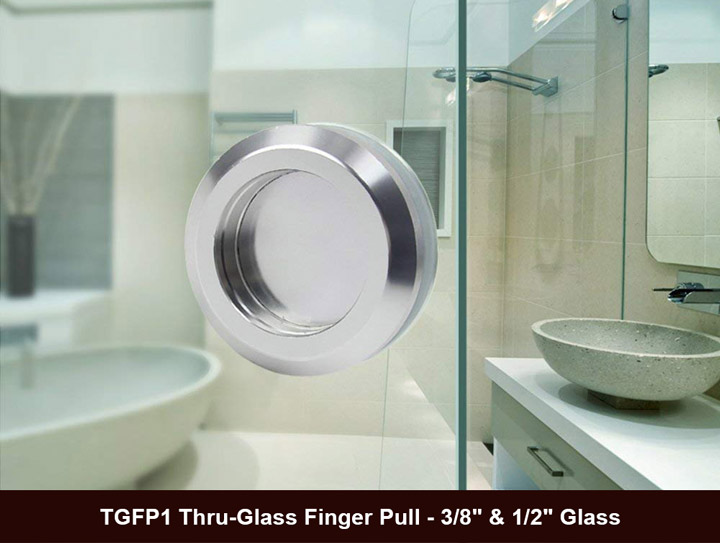
.
.
4. Can different types of hinges be used on glass doors?
Absolutely! A homeowner’s choice of metallic finish can also be included in a shower design by way of the hinges. Three types of hinges are used on glass shower doors:
- Wall mount hinges: You can probably see this type of hinge on your front door and most of your home’s interior doors. In shower design, these hinges are used to attach a glass door panel to the adjacent wall.
- Glass-to-glass hinges: Glass-to-glass hinges are similar in design to wall mount hinges, but they are designed to attach a door panel to an adjacent fixed panel of glass. They operate in the same way as wall mount hinges.
- Pivot hinges: Pivot hinges attach a door panel to surfaces above and below. The door opens by pivoting on the hinged point. The hinges are attached to the door’s upper and lower edges at the same distance from the vertical edge.
Wall mount and glass-to-glass hinges provide a traditional look and enable the door to fully seal. Pivot hinges offer a contemporary appearance. They don’t allow the door to seal, but they are more low-profile than their wall-mount or glass-to-glass counterparts. A homeowner who wants to keep the focus on the glass might choose Polished Nickel pivot hinges, while a homeowner who views the metal components as ornamental accent pieces, might prefer wall mount or glass-to-glass hinges in Satin Brass, Matte Black, Brushed Bronze, or another dramatic finish.

.

.

.

.
.
5. How are clamps used in frameless shower design?
On a framed shower an aluminum frame provides stability and connects pieces of glass. However, on a frameless enclosure, hinges, clamps, and caulk joints take the place of this framing. Clamps can connect pieces of glass to each other or connect a glass panel to an adjoining surface. These are small pieces of hardware, as compared to a full frame. They are available with square or beveled edges and in a variety of finishes. Brushed Bronze and Satin Brass clamps can be rather decorative, while Polished Chrome, Polished Nickel, and Brushed Nickel are more unobtrusive. Highly popular Matte Black clamps boldly draw the eye and ensure that the hardware is a key aspect of the design. On a frameless enclosure, you might see clamps:
- At corners of the enclosure
- Joining the lower edges of glass panels to the shower curb
- Connecting glass panels to adjacent tiled walls
- Holding two pieces of glass together
.

.

.
.
6. Is U-channel ever needed on a glass shower enclosure?

U-channel is used in a few different ways on glass enclosures:
- U-channel can be utilized to attach glass panels to the walls or floor.
- When clear glass is surrounded by Matte Black U-channel and ceramic frit gridwork is applied to the surface, the glass takes on the grid style, which is inspired by steel-framed windows.
U-channel is a conspicuous metal component on a glass shower, so the choice between a classic finish like Polished Chrome or Brushed Nickel and a fancier finish like Brushed Bronze or Satin Brass becomes a very important one. Homeowners should consider the following points when selecting a U-channel finish:
- Do you want matching metals or mixed metals in your bathroom?
- If you are redoing the whole bathroom, what look do you want? Finishes in the silver family are cool and sleek, while finishes in the gold family are warm and ornamental.
- Is the popular blend of clear glass and black metal something you want to integrate into your bathroom?
.

.
.
7. Are other components needed besides glass and metal?
Glass is the main element on a shower enclosure, and metal is an important secondary component, but other less exciting materials are also needed. While these don’t offer the aesthetic benefits of glass and metal, they are needed for the proper functioning of the glass shower door. These items can include:
- Vinyl seals around the door
- Vinyl sweeps between the bottom edge of the door and the curb
- Acrylic shower thresholds
- Vinyl wipes between the lower door edge and the curb
Seals, sweeps, thresholds, and wipes help glass shower doors contain water within the enclosure and avoid leaks on the shower floor. These are designed to be barely noticeable, so they are typically clear.
.

.
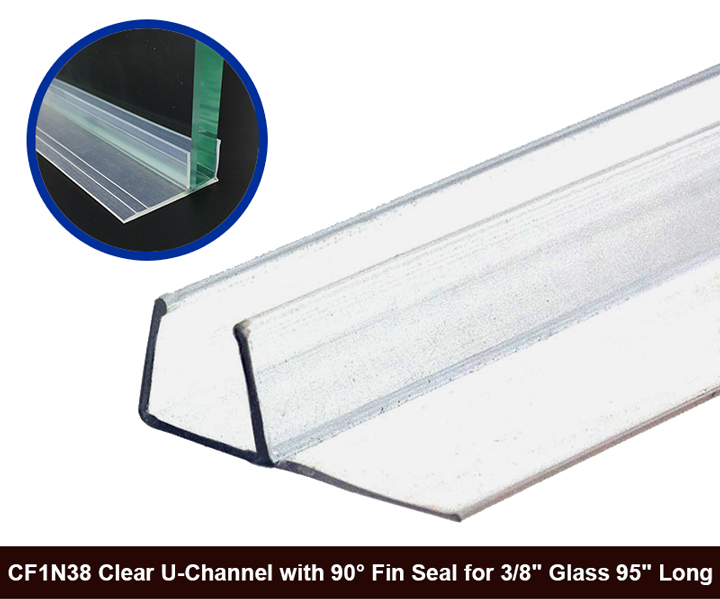
.
.
8. What are the best options for minimizing metal?
In spite of the popularity of Brushed Bronze, Satin Brass, and Matte Black hardware, some designers want to make the metal components as inconspicuous as possible. Here are some tips for achieving this:
- Finishes in the silver family blend in with the glass more than bolder finishes.
- A brushed finish like Brushed Nickel has a softer appearance than something like Polished Chrome.
- A shower design that does not require a header typically has very little metal.
- Pivot hinges are less visibly prominent than glass-to-glass or wall mount hinges.
- Rolling glass doors include more metal because rollers and a header are needed for door operation.
- Knobs and finger pulls are smaller handle options than pull handles and towel bars.
As you can see, the goal of minimizing metal will impact a homeowner’s choice of enclosure design, door type, metal finish, and individual pieces of hardware.
.

.
.
9. What about ornamental hardware that dresses up the enclosure?
On the other hand, a designer may want to highlight a shower’s metal components and use them to dress it up. In this case, striking metallic finishes and fancier designs will be chosen. Pro tips to consider are:
- Oil Rubbed Bronze and Matte Black finishes create a nice contrast to clear, frosted, tinted, and cast glass. This contrast is in harmony with the Japandi style and is visually pleasing in bathrooms of any style.
- Brushed Bronze and Satin Brass add richness to a glass shower door and can be very ornamental.
- In a modern bathroom, a ladder style handle adds visual interest.
- An ornate pull handle can give the whole enclosure a more formal vibe.
- Bold framing around a shower screen gives it character and definition.
.

.
.
10. How can I get the shower hardware needed by my business or for my DIY project?
Shipping delays and supply chain disruptions are a real problem, whether you are a glass company, contractor, or DIYer. Business owners need to meet customer demand for specific pieces of shower hardware available in trending finishes like Satin Brass, Matte Black, and Brushed Bronze, but this is hard to do if you’re plagued by items on back order, shipments arriving late, and so forth. Glass Simple is a company that’s committed to taking the hassle out of getting the shower hardware you or your customers need. We are an authorized FHC hardware dealer, and all items shown on our website are in stock. We offer a variety of handles, hinges, clamps, seals and the like, with hardware available in assorted finishes. Glass Simple is also committed to processing and shipping out orders in a timely manner, so you can stay on schedule. If Glass Simple sounds like the answer to your hardware needs, we invite you to:
- Browse our website to check out our great selection.
- If you are a business owner, call us at (571) 707-7760 to set up an account and receive discounts of 25% or more.
- Start shopping today and take the hassle out of getting the shower hardware you want!
.


